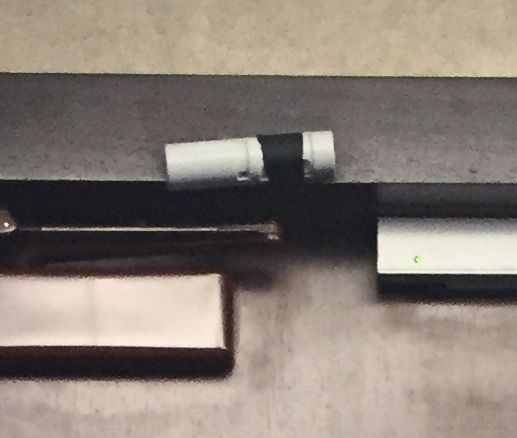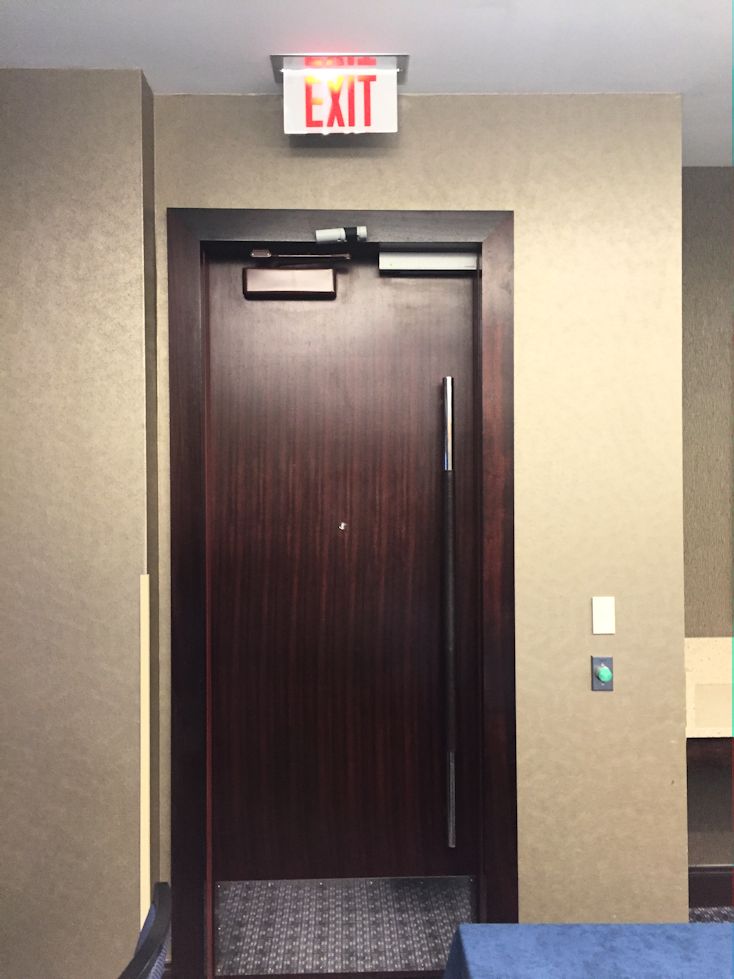When an electromagnetic lock is installed on a door in a means of egress, there are two options for code-compliant releasing operations. One option is for the mag-lock to be released by door-mounted hardware (and also upon power failure). The other is for the mag-lock to be released by a sensor, along with a push button, power failure, and the fire alarm system. Sometimes a system incorporating a sensor can be problematic, because traffic moving past the door can inadvertently unlock the mag-lock.
Jeff Dunham of BEA Inc. sent me these photos of a door with a sensor that was intended to release the mag-lock. The sensor has been rendered useless by black electrical tape, so the door would not unlock for egress unless the push button beside the door was pushed. It sounds like the push button may have been wired incorrectly as well, since there was a 2-second delay before the lock would release. The IBC requires the following with regard to the push button: “When operated, the manual unlocking device shall result in direct interruption of power to the lock—independent of other electronics—and the doors shall remain unlocked for not less than 30 seconds.”
Ironically, the doors were serving a room that was being used for a product liability seminar.
You need to login or register to bookmark/favorite this content.







If the PIR is not tuned well then you get clients “fixing” it this way.
This is one of the reasons that many fire marshals on the west coast are so reluctant to approve mags.
Whenever a mag application is denied I ask to meet them on site. Once they see how it works they are uniformly OK with it. They tell me one that works is the exception. Sad but true.
Who puts a medium bronze closer on a door with a mirrored (err, polished chrome) kickplate?
Not sure what bothers me more……
the tape or the crooked, poorly mounted PIR
Ahh, the wonders of modern man and electrical tape. And what knucklehead thought that it would look really cool to specify a door pull on the “push” side of a door?
But the guys that know what they’re doing are too expensive.
What are the requirements with regard to the active sensing area and response time? Would a light curtain mounted to the door frame be acceptable if it would cut power before someone moving at normal walking speed would reach the door? Active-scanning light curtains would seem like they’d be less likely than PIR sensors to either trip inappropriately or fail to detect objects within their field, and would be fail-safe rather than fail-secure when their view is obstructed.
The codes just say that the mag-lock has to be unlocked by a sensor detecting an approaching occupant, so it could be any type of reliable sensor as long as the AHJ doesn’t object.
– Lori
The AHJ interpretation of “sensor detecting an approaching occupant” is widely different across the USA.
I’m not aware of any specific detection pattern size. There are products available today that have a large pattern which is probably why we have black electrical tape on this sensor. This sensor pattern shape seems more of a convenience vs security.
However, there are other sensor products that have a focused detection pattern that can detect a occupants hand or arm reaching for the door and then and only then unlock the door. Seems at times the AHJ doesn’t approve of this method. In reality isn’t this type of sensor creating a more secure environment where nuisance unlocking doesn’t occur?
Shouldn’t this be positively latching, assuming it’s a fire-rated door?
Hi Nelson –
I don’t think this is a fire-rated door. If it was, then yes – it would need to have positive latching.
– Lori